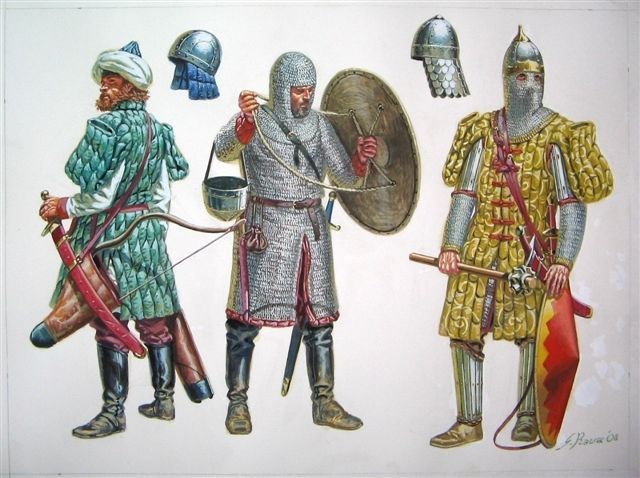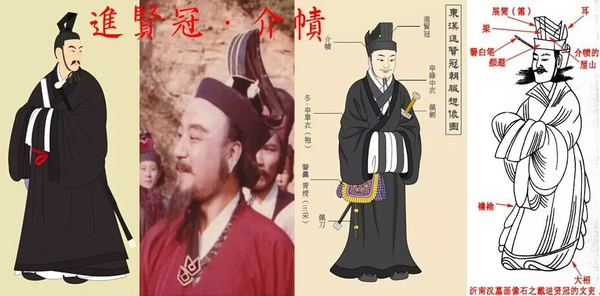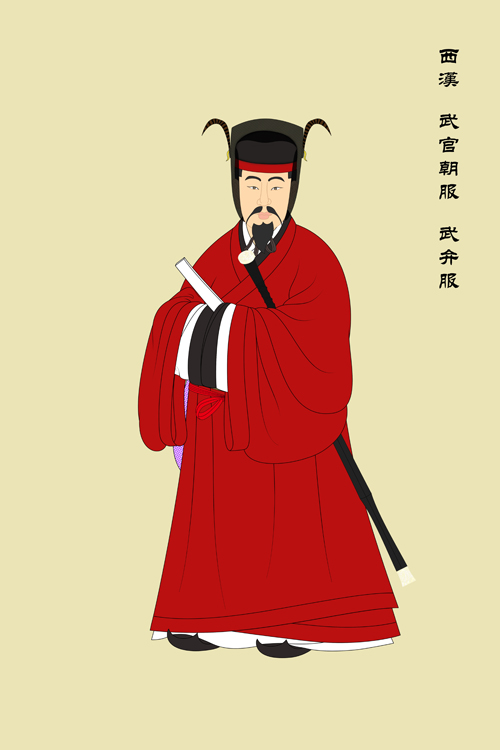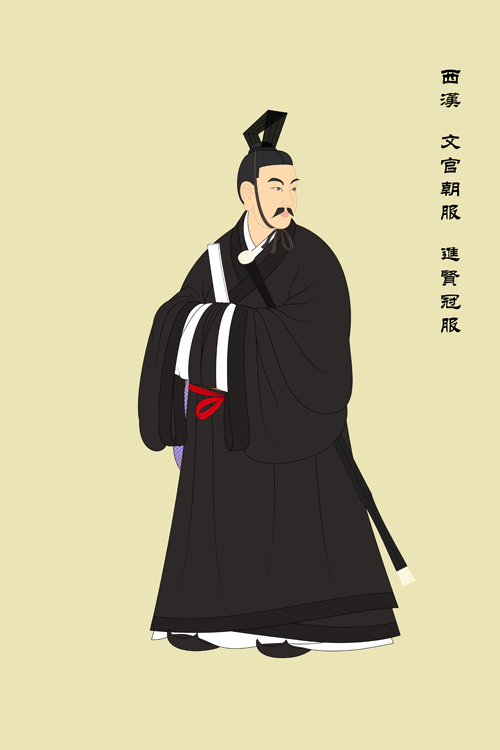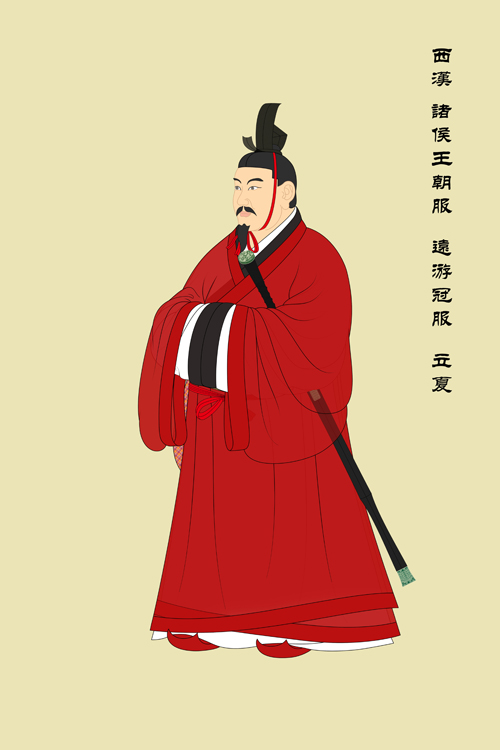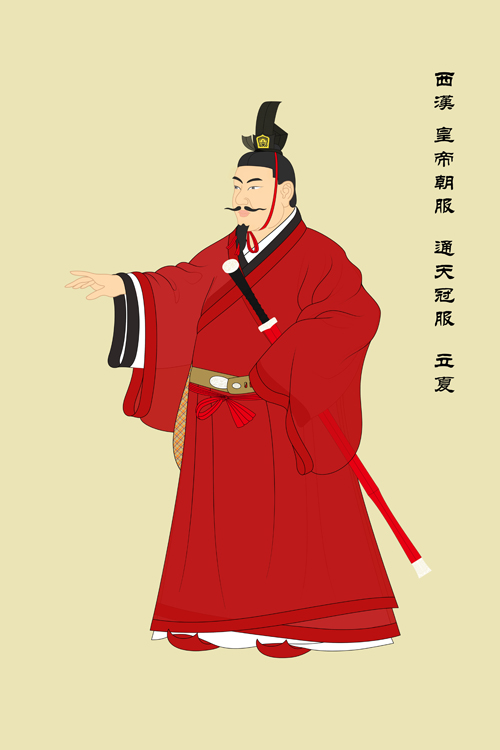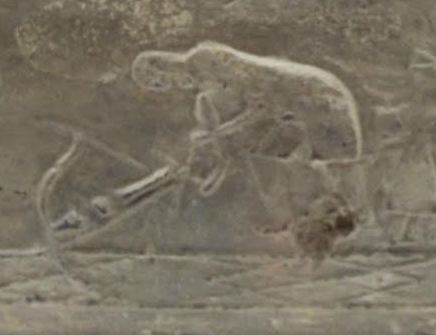
wolflance
Community Members-
Posts
241 -
Joined
-
Last visited
-
Days Won
5
Everything posted by wolflance
-
Byzantine cataphract actually look like this: (The yellow guy) Almost entirely of his armors are hidden under the padded kavadion. The good news is that this can potentially save a lot of trouble for the 3D modelers, since barely-armored grunts wear exactly the same kavadion as the most elite cavalrymen.
-
Those actually look like/took inspiration from something a Samurai would wear... Well, unlike later periods, the "mandarin robe" had not been formalized during Han Dynasty, so the relevant researches are fewer. Best I could find so far: Below: Western Han, Military official Below: Western Han, civil official (yes, those are two-handed sword/jian. Even civil official carries it) Below: Western Han Aristocrat (Outdoors outfit during the beginning of summer) Below: Western Han Emperor (2nd level formal outfit during the beginning of summer) Emperor and aristocrat (and possibly other officials) apparently wear different color for different time of the year. Blue for spring, Red for beginning of summer, Yellow for end of summer, White for fall, and Black for Winter.
-
These robes are inaccurate. Drama costume probably.
-
Sorry for the late reply. The 146cm Three Kingdom Wu sword is kept at Ezhou Museum, Hubei, China. The museum has a website (in Chinese, for obvious reason), although this sword is not displayed on their site. http://www.ezbwg.com/ The Osprey books give only the most rudimentary outline of ancient Chinese military, and their illustrations (on Chinese armies) are really crap. The lack of research material in English is regrettable, although understandable, as even the Chinese ones are fragmentary and basically all over the place. For example, apparently there exists a Eastern Han Dynasty brick carving that depicts a soldier spanning a WINDLASS CROSSBOW, but no one seems to be talking about it or even aware of it.
- 82 replies
-
- 2
-

-
- Asian
- Han Dynasty
-
(and 2 more)
Tagged with:
-
Heroes and Champion Unit for Han Dyanasty
wolflance replied to Mega Mania's topic in Rise of the East
If weapon switching is possible, multi-role units will indeed fit the Chinese Champion quite nicely. There were numerous "guard" units during Han period, although Qi Men, Yu Lin and Hu Ben are some of the more famous ones. -
Straight-edged dao was the mainstay sidearm from Han to Song Dynasty. After the Mongols conquest, they switched to the curved sabers we know today. China was one of the earliest civilization to make common use of two-handed sword with definite archaeological proofs (the Indian predate them in two-handed sword usage, but they have scant archaeological findings). They had two-handed bronze sword (jian) even. The longest Han Dynasty two-handed dao seems to be a find dated to Three Kingdoms period (Wu Kingdom), measured at 146 cm. Most are around 110~120 cm range though, similar to 15-16th century European longsword. Wu Kingdom two-handed dao. This is NOT a replica. As a side note. the Chinese also had cavalry dao with knuckle bowl handguard.
- 82 replies
-
- Asian
- Han Dynasty
-
(and 2 more)
Tagged with:
-
ROTE Xù yuē 17 - Impression and suggestion on historical accuracy
wolflance replied to wolflance's topic in Rise of the East
Wow, I have not come here for some time. Sorry for the very very late reply. Yes, Han definitely had foot archer. Like many Eastern cultures, Chinese was very, very, VERY fond of archery (Chinese was the last civilization to give up archery as a battlefield weapon), so there's no lack of archer of any forms. That being said, if you want to trim down the unit roster, then foot archer should indeed be the first to go. I think I said this years before, but one problem for the Han RTS faction is that they are too "complete". The Chinese just had......basically every unit imaginable. Everything from spear (foot and mounted), halberd/ji (foot and mounted), sword+shield (foot and mounted), archer (foot and mounted), crossbow (foot and mounted), chariot, war wagon, wagon-mounted siege crossbow, battering ram, trebuchet, heavy siege crossbow, siege tower...Chinese was also one of the first civilizations to have two-hand sword (only Indian predates them). (As a side note, they apparently also used full iron javelin like the celts, but not in large number.). -
Not being here for a while and the image links are all dead
-
Those (latest pictures) are daos alright . Guy at #22 is holding a Jian though.
- 82 replies
-
- Asian
- Han Dynasty
-
(and 2 more)
Tagged with:
-
Reconstruction by Cang Ning Jun (蒼凝君) of Mu Feng Guo Jia (沐風國甲, can be roughly translated to “Wind-bathing National Armour”). Cang Ning Jun is not his real name. Available at Taobao. No, really. Let's just say Han warrior kick @#$%. Not sure about the scarfs, but given that Han Dynasty fought Xiongnu in the desert, it was not out of place. Good showcase of how long a two-handed Han sword can be, and more importantly, Han quiver. That being said, the swords seem overly ornate, and I am also not too sure about the boot.
- 82 replies
-
- 1
-

-
- Asian
- Han Dynasty
-
(and 2 more)
Tagged with:
-
Yayoi Japanese were indeed quite unique - certainly more tribal-like than their more sinitized Kofun ~ Asuka descendant, although I am not sure if we can find enough information to make a full civ out of it. Warrior in twin-tails (haistyle) seems awesome though. (for example the unit choice seems quite limited - spear, axe, sword, shield, bow, i think that's about it. Crossbow if we want to stretch it a bit, but no slinger, no javelin AFAIK, no horsemen of any kind and no chariot of any kind. Although Yayoi Japanese had warships, we don't know what it look like).
-
Reconstructed Tang Dynasty armoured cavalry. Yes, no boob-plate(s). For more picture, visit my Han period reconstruction clothing thread at ROTE section.
-
Tang Dynasty Male Peasant This might be a WIP. The leather belt seems too high-class for mere peasant.
- 82 replies
-
- Asian
- Han Dynasty
-
(and 2 more)
Tagged with:
-
Note: This is obviously not for ROTE, but I will put it here for completeness's sake. TANG DYNASTY Armoured cavalry. The armour plates are based on actual excavated examples, but the overall look is reconstructed from visual-only sources (paintings, murals, figurines, lokapala, etc) This is also the best Tang-period armour reconstruction I ever seen (not that there are many - to my knowledge only two Tang armour reconstruction had been attempted, and the other one sucked).
- 82 replies
-
- 1
-

-
- Asian
- Han Dynasty
-
(and 2 more)
Tagged with:
-
Emperor Wu of Han (Han Wu Di) period heavily armoured trooper. Probably elite or high-ranking. He is apparently an archer, see the bracer on his left arm. (However most professional Chinese troops would be at least accustomed to archery). Also, this (and the armor above) is one example of the so-called Tong Xiu Kai (筒袖鎧), lamellar armour that has complete tube-like sleeve so to not expose the vulnerable armpit (a common weakness found on almost all lamellar armour).
- 82 replies
-
- 1
-

-
- Asian
- Han Dynasty
-
(and 2 more)
Tagged with:
-
Update: Apparently Hu Jing Ming created more clothing reconstruction recently (recent as in October 2015). This time not limited to the Han. These are also reconstruction by Cang Ning Jun. Late Western Han Armored Officer. Two-handed Sword (Jian, since he's an officer). Hell yeah. Also, beards!
- 82 replies
-
- 1
-

-
- Asian
- Han Dynasty
-
(and 2 more)
Tagged with:
-
How would the Carolingian cavalrymen compare to the cavalry of other civs? (i.e. Normans)
-
I believe putting siege crossbow on tower is by no means a Chinese-only practice tho. So I put the upgrade under the assumption that everyone else will get similar upgrade(s)...There are discussion on other vanilla thread that want to nerf early tower but gives them more upgrade later on, so I was thinking along that line. I am OK on three separate tower too.
- 56 replies
-
- mil
- ming dynasty
-
(and 8 more)
Tagged with:
-
They lasted that long partly because of the Southern China's terrain, which isn't very suitable for cavalry-based army (Mongols were not very good infantry and sailors - not yet), and partly because the Mongol themselves were at (two separate) civil wars that lasted from 1241-1251 and 1260-1264, the second one essentially split the Mongol Empire into many smaller khanates (that are hostile to each other). Meng Gong did a respectable job beating the Mongol in the first phase of the war though. If only he lived longer... My current proposal put both the chuangzi nu and flamethrower as upgrade for tower (less building model to worry about), so a fully upgraded Chinese tower can shoot three different weapons at the same time (normal arrows, Chuangzi bolt, and fire), plus whatever the garrisoned guys can shoot. I am considering the 震天雷 iron-cased bomb as upgrade for tower as well, which I visualize as an close (almost melee) range, very large AOE one-hit-kill attack for the tower to deter melee assault. Maybe make it an manually activated ability. The Chuangzi nu has a separate, mobile siege weapon version.
- 56 replies
-
- mil
- ming dynasty
-
(and 8 more)
Tagged with:
-
@Ayakashi As I said before I am more of a historical accuracy type of person than a RTS balance guy ---- That said the points you raised are all very valid, I did not think it thoroughly when I was drafting the roster in my pursue on historicity. The Song Chinese...well, in term of military capabilities, they are really the weakest among all the China's dynasties (relatively speaking). They had to rely on numerical superiority to win battle, although they did not use 'human wave tactic' per se, instead they opt for massive amount of crossbowmen. They really did get roflstomped a lot too, but I guess getting too accurate wouldn't made for a fun or balanced RTS.
- 56 replies
-
- 1
-

-
- mil
- ming dynasty
-
(and 8 more)
Tagged with:
-
Yes, I am inclined to choose Jin as well, because they are also the only faction that 'make sense' to appear in Song army. Song and Jin did formed an alliance to destroy Liao, after all (It came back to bite them in the @#$%, but that is beside the point XD) Then again, there are many historical source that suggest that Iron Pagoda is actually a type of heavy infantry (instead of Cataphract).
- 56 replies
-
- mil
- ming dynasty
-
(and 8 more)
Tagged with:
-
Each has their own charm and unique unit - Jin has the Iron Pagoda cataphract and the so-called "chained horse"/Guai Zi Ma (with dubious historicity), Liao has Iron Forest Army, Eagle Army and Elite scout. Xi Xia has Iron Sparrowhawk cataphract, Mountain Infantry, Elite Slavetaker, Camel trebuchet, gunpowder grenades and bronze cannon (they are one of the possible 'way' that we can get cannons for the Chinese for part 2) . They also has the best sword, Shen Bi Nu crossbow (this one was reverse-engineered by the Song fairly early though), and extremely tough cold-hardened iron armour.
- 56 replies
-
- mil
- ming dynasty
-
(and 8 more)
Tagged with:
-
Good idea, although I cannot decide whether to choose from Jin, Liao, Xi Xia, or even Mongols.
- 56 replies
-
- mil
- ming dynasty
-
(and 8 more)
Tagged with:
-
Of course, all these types of sword show up in Tang period artwork: Ring-pommel sword. The "Swordstick" The "Sassanian-influenced" style. On the other hand, the round/square & flat tsuba-like guard are not present in historical artworks. And something with exaggerated guard like this is DEFINITELY not historical.
-
Here are all Chinese Sui-Tang swords currently preserved in Japan that I could find: Sui Period sword: The '水龍劍' or 'Water Dragon Sword'. The hilt mounting is from later period. 丙子禦林, only the blade survived. '七星劍' or 'Seven Star Sword'. Only the blade survived. Tang Period sword 吴竹鞘御杖刀. This one is probably the more representative of the Tang Dynasty 'non-ring pommel' sword. I think some Tang period murals showed similar sword mounting. The name indicates that it is a swordstick. 金銀鈿荘唐大刀. This Tang Dynasty sword shows a lot of Sassanian influence. It is actually a backsword, to be precise (only the sword point is double-edged). Another sword with the same name but has a more traditional "tanto point". 金銀平脫莊橫刀. More dagger than sword though. 銀飾寶石唐短刀.Twin daggers. Other allegedly Tang Dynasty sword: 金銅黒漆装唐直刀. The gigantic 256cm sword, claimed by some to be a Tang Dynasty sword as well, although unverified. Its real name is 布都御魂 or 韴霊剣 or Futsu-no-mitama. Yes, it is THAT Futsu-no-mitama from the famous Japanese mythology, welded by Japanese warrior god Takemikazuchi (although it is not the only sword to bear that name, just like there are many so-called 'Lance of Longinus'). Such a famous weapon would be very unlikely to came from China. 銅裝黑漆大刀. This is a fully Japanese sword made "in Chinese style". So, our reference pool is surprisingly small - our four Tang Dynasty swords (plus a pair of daggers) have very few in common with each other - different blade profile, different scabbard, different guard (and no guard in the case of 吴竹鞘御杖刀) and different hilt.

